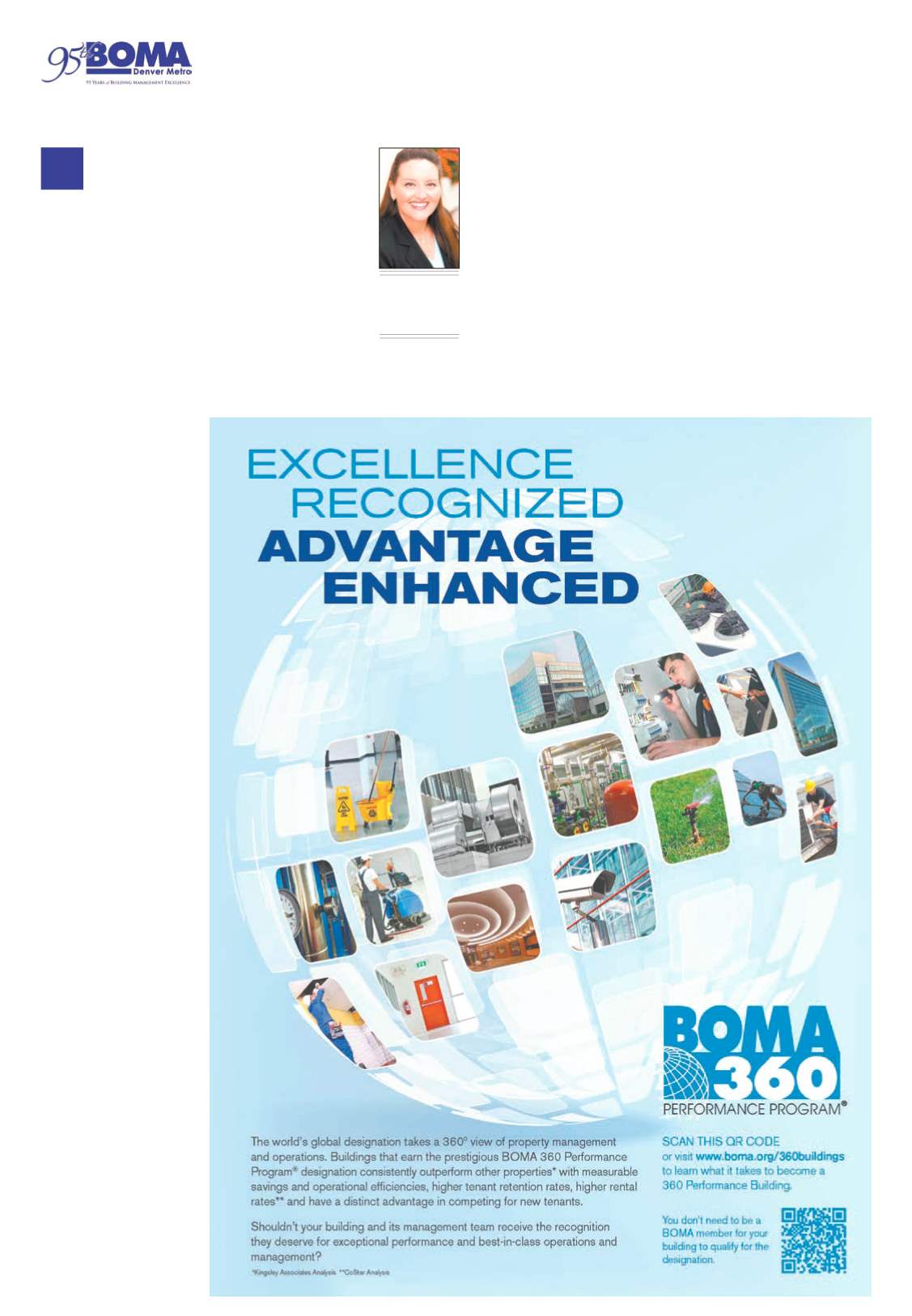
September 16-October 6, 2015 —
COLORADO REAL ESTATE JOURNAL
— Page 13B
Spotlight
ake everything you
know about LEED for
Existing Buildings:
Operations &
Maintenance (LEED EBOM or
LEED O+M) and forget it.
Over the past few years, the
U.S. Green Building Council
has been working on a platform
called LEED Dynamic Plaque.
When it was first presented
at the Greenbuild Conference
in 2013, attendees were left
pondering the purpose of this
program, what it did, how it
worked and why it was devel-
oped. Now, the USGBC is offer-
ing LEED Dynamic Plaque as
an alternative path to recertifi-
cation for LEED O+M projects.
LEED O+M is the only certi-
fication that expires. The con-
struction rating systems simply
certify the initial construction
or remodel work, but don’t
necessarily certify whether the
building is going to perform
well when people move in. The
only way to get a third-party
certification of how a building is
performing is to use the LEED
O+M system; but because
operations change over time,
the O+M certification expires
after five years. Now that the
early adopters of LEED O+M
are up for recertification, there
has been some hesitancy to go
through the standard recertifi-
cation process.
The first time buildings go
through LEED O+M they
need to document at least
three months of operations
and maintenance practices. To
recertify the building, there are
different tracking categories
for different prerequisites and
credits. Most practices have
to be documented for 13 or
14 months (the “most recent
25 percent of the recertifica-
tion performance period”),
and some practices have to be
documented since the initial
certification (for example, shar-
ing approximately 4½ years of
repair and maintenance activi-
ties on the janitorial equipment
for the IEQc3.4 Green Cleaning
– Sustainable Cleaning
Equipment credit). Therefore,
documenting more data trans-
lates into consulting fees that
often are equal to those paid
for the initial certification. And
that’s where the problem comes
in – some commercial real
estate owners are not eager to
pay consulting fees every five
years to keep their LEED O+M
certification, but do not have
the manpower or expertise to
complete the process in-house.
We also haven’t seen most of
the buildings certified by the
construction rating systems
pursue LEED O+M certifica-
tion. So, although they were
built sustainably, they are not
moving forward with a certi-
fication to audit how they are
actually performing.
For these reasons and more,
the USGBC is launching
LEED Dynamic Plaque. LEED
Dynamic Plaque benchmarks
ongoing building performance
across five categories: energy,
water, waste, transportation
and the human experience.
Ideally, monthly energy, water
and waste data are shared
via
An annual
transportation and occupant
satisfaction survey must be
performed, and annual carbon
dioxide and VOC testing is
required.
That’s it.
This is a dramatic change
from the highly prescriptive
and documentation-intensive
LEED process we know to
date. The theory behind this
new platform is that it docu-
ments results. According to
the USGBC, if a building is
extremely energy-efficient they
should simply share their ener-
gy data instead of documenting
another energy audit or how
the BAS is maintained. Instead
of theoretical plumbing and
landscape calculations, build-
ings simply share their whole
building water use.
So, it’s easy … and it’s cheap.
The USGBC is asking an
annual fee of $1,800 for annual
recertification of the building
using this platform. So what
are the down-
sides?
The LEED
Dynamic
Plaque ener-
gy perfor-
mance score
is not based
on Energy
Star bench-
marking – a
tool embraced
by a vast
majority of
the market.
Instead,
the USGBC
has devel-
oped its own algorithms for
energy and water performance
based on the data from other
LEED certified buildings – a
relatively small sample as less
than 1 percent of buildings
are LEED certified. Currently,
the USGBC says the scoring
information/calculation is pro-
prietary, so we do not know
what our “performance score”
will be on energy or water until
we enter our data into the
platform. This is very differ-
ent from our current practice
of using Energy Star and the
LEED scorecard to systemati-
cally build a program to secure
LEED Certified, LEED Silver,
LEED Gold or LEED Platinum
for five years.
Another item to consider is
that the building will recertify
upon its anniversary annu-
ally. Therefore, it is possible
to achieve LEED Silver in
Year 1, LEED Gold in Year 2,
LEED Silver in Year 3, LEED
Certified in Year 4 … etc. If the
level of certification is unim-
portant, this may not be an
issue. For those who are LEED
Platinum and want to stay
LEED Platinum, this annual
fluctuation may prove problem-
atic.
Finally, will this approach be
accepted by the market? Will
this affordable “performance-
based” platform open LEED
certification to buildings priced
out by the current system? Will
this simplistic approach be
viewed as greenwashing? Will
it continue to transform com-
mercial real estate and multiple
industries the way LEED has
to date? Only time will tell.
T
Amanda
Timmons,
LEED AP
Ampajen Solutions
LLC


